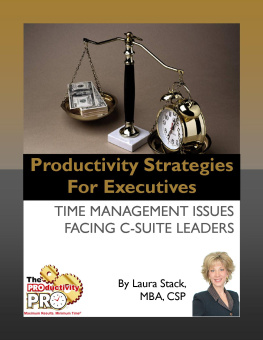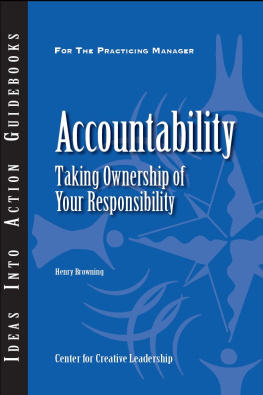Table of Contents
Productivity Strategies for Executives
Time Management Issues Facing C(X)O Leaders
Introduction
In my most recent book, SuperCompetent (John Wileyand Sons, 2010), I identified and described six keys that anyone can use in theworkplace to maximize their performance: Activity, Availability, Attention, Accessibility,Accountability, and Attitude. Recently, I've been considering how all sixaffect C-Suite executivesthat is, upper-level executives like the CEO, CFO,CIO, Presidents, VPs, and Directors. What issues, concerns, and challenges dosenior leaders face in these areas?
As it turns out, these concepts look a bit different at thehighest levels, so the standard approaches don't necessary apply. In manycases, even the names have to be changed. This is why, at the C-Suite level, Iprefer to refer to my keys as Prioritization, Scheduling, Focus, Organization,Efficiency, and Attitude, respectively.
In this eBook, I'll take a look at the C-Suite version ofActivity: Prioritization.
Key #1: ActivityPrioritization
In general, Prioritization is the order in which youorganize those things most important to you: your religion, your family, yourlife goals, your daily work. It's necessary to look closely at each one, anddetermine which items need to come first and how everything else should follow.All these categories are important, of course, but what we're concerned with inthis venue is the business aspect of the equation.
In the work arena, Prioritization may involve severaldifferent levels of responsibility, starting with the personal Activitystandards required of any effective individual: a strong sense ofself-discipline, written goals, strict to-do lists, a tight focus, and a drivefor efficiency, just to name a few. However, in my opinion the most significantlevel of C-Suite Prioritization is the order in which you prioritize yourorganization's operations and projects (at least those within your bailiwick).This involves careful, long-term planning in which cost/benefit analyses,delivery timeframes, resource allocation, and similar factors have to be takeninto consideration for new projects, along with the organization (andreorganization) of existing projects for which all of the above have alreadybeen taken into account.
Large-scale Prioritization is rarely a solitary exercise.While you may or may not have the authority to prioritize by fiat, in mostcases the most logical method is to sit down with the high-level stakeholdersof the projects at hand (Directors, VPs, etc.) and hammer out which ones needto come first and why. If nothing else, this kind of review can make it easierfor the executive team up the ladder to make its final decisions, and itprepares you to spring into action once those decisions have been made.
Properly done, Prioritization will also hone yourorganization's efficiency. When you sit down to prioritize, look at ways thatdoing so might make the work flow simpler and easier, increasing speed andprofitability. Keep in mind that true prioritization is proactive, rather thanreactive; that is, you prioritize ahead of time based on projected needs,rather than prioritizing on the spur of the moment because the situation forcesyou to. Proactive planning allows for a level of flexibility and cleanefficiency that reactive prioritization lacks. It's very difficult to takeevery factor into account when you're reactive, and eventually, thatinefficiency will catch up with you.
And remember, Prioritization involves more than simplychoosing which items come first: you also have to deal withlower-priority items, determining where they need to fit into the work structureorif they should fit at all. Don't be afraid to tap subordinates when makingthese lower-level Prioritization decisions. While the buck should stop withyou, you must be willing to delegate some decision-making power in order to a)protect yourself from being overwhelmed and making mistakes; and b) to empowerthe people under you, so that they can use their own creativity to solveproblems. Don't abdicate your responsibility for anything, but be sure tooversee rather than micromanage. At your level, you need to free up the timenecessary to revisit your objectives consistently and rattle cages, whennecessary, to move things along.
Which brings up another point about Prioritization: at somelevel, the requirements of executives more senior than you may take precedenceover your priorities. Even if you're at the top of the heap, a Board ofDirectors or stockholder group may have the final say. But it's yourresponsibility to convince them of the value of specific projects, and to makerecommendations regarding their priority. They may or may not listen to you,but even so you have to do the best you can to champion whatever you believe ismost important for the company or organization, based on your understanding ofits priorities. Once the decision has been made, however, it's up to you toprioritize based on those higher-level decisions, whether you agree or not.
Key #2: AvailabilityScheduling
One of the core keys of SuperCompetence is Availability:your willingness and ability to protect your time, so that you can accomplishyour desired activities. At the C-Suite level, this translates asSchedulingand Scheduling is about more than just accomplishing the things thatyou want to accomplish. CEOs, CFOs, Presidents, VPs, Directors, and similarhigh-level executives have responsibilities that far transcend the averageworker's; the fact that they tend to face those responsibilities in muchplusher surroundings doesn't obviate the reality that, more than ever, they'rehemmed in by their need to limit their availability.
Like Prioritization, Scheduling requires very closeattention to what's truly importantand it's critical to getting anythingimportant done at all. Once you reach the top, you have to protect your timediligently if you want to keep accomplishing things that are valuable to theorganization. You can't allow yourself to be distracted by the mundane: thatis, it's not up to you to run around putting out brushfires, especially whenother people can do so less expensively. That style of management comesperilously close to micromanaging, and it's even more harmful for theupper-level executive than it is for lower-level managers, because it moredirectly harms the entire organization.
That's something that you should always keep in mind as youclimb the corporate ladder: in almost every case, what you do as a C-Suiteexecutivewhether good or illwill affect the organization more than anythingyou did while you occupied lower rungs on the ladder. You forget that at your peril,as debacles like Enron and AIG make readily apparent.
This applies at the personal level, too. Because you have tofocus on high-level tasks, there's not much time left to make yourselfavailable to the lower echelon. While it would be nice to maintain an open-doorpolicy like mid-level managers sometimes do, that's not usually a realisticoption for the top-level execeven though some companies have started to movein that direction. Some, in fact, have gone so far as to put their upperexecutives in offices that leave them completely visible to all and sundry, ala Mayor Michael Bloomberg's open-space office in New York City.
While this is an interesting and even refreshing change fromthe old days, when executives closeted themselves away in inaccessible innersancta protected by secretarial dragons, I don't believe openness andavailability is going to work for them in the long run. To some extent,high-level executives have to remain cloistered from the hoi polloi.There's nothing elitist about this: it's just that people at the very top havetoo much on their plates already to be bothered by low-level considerations.















